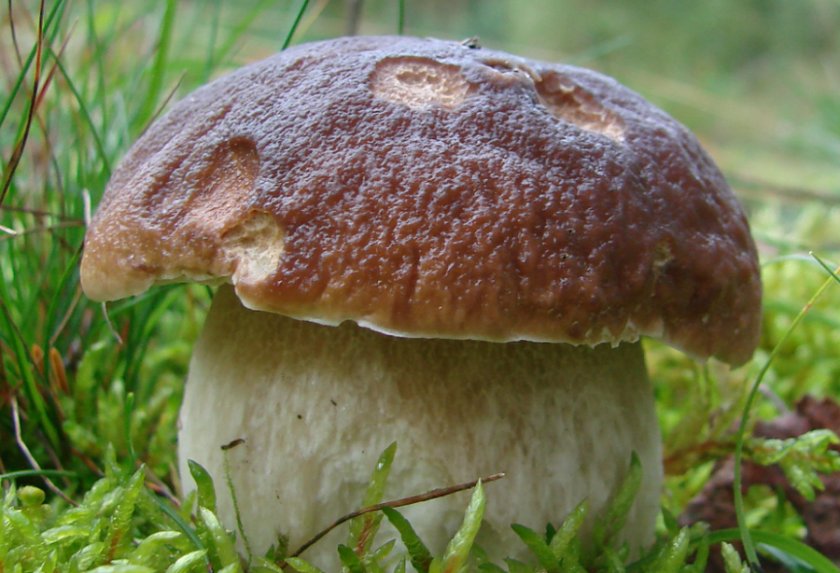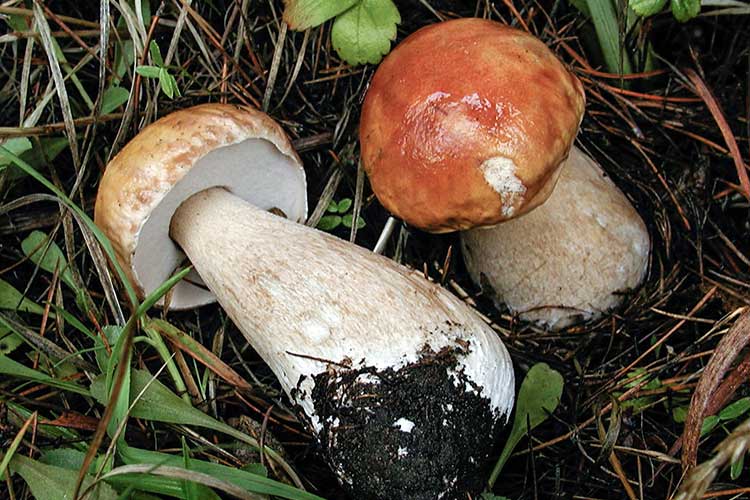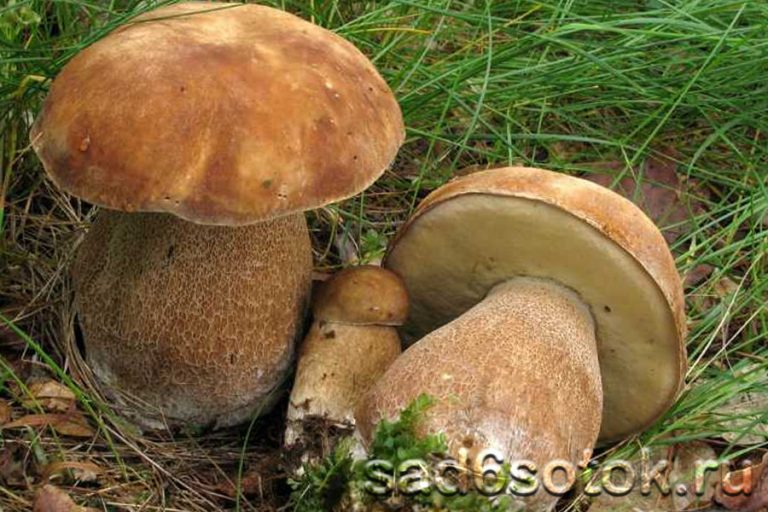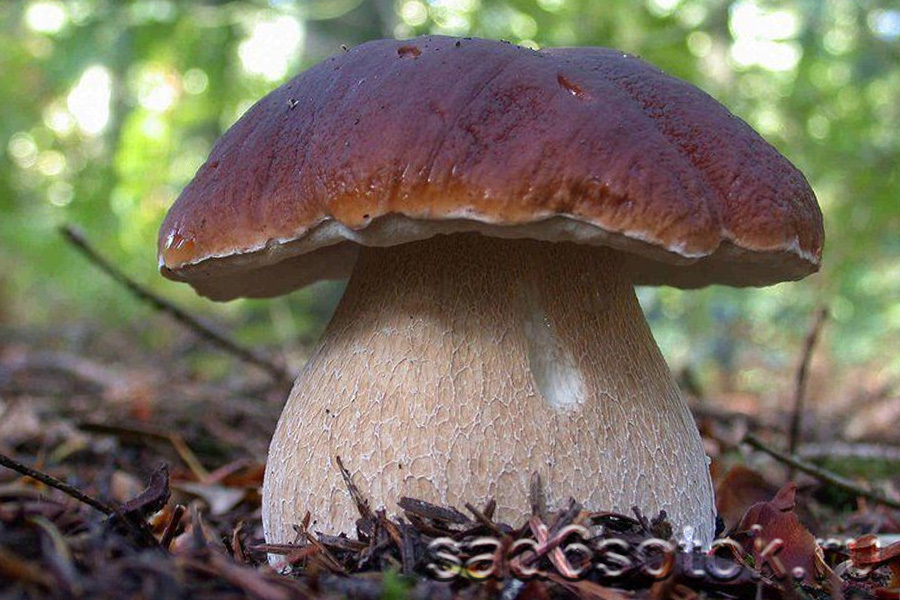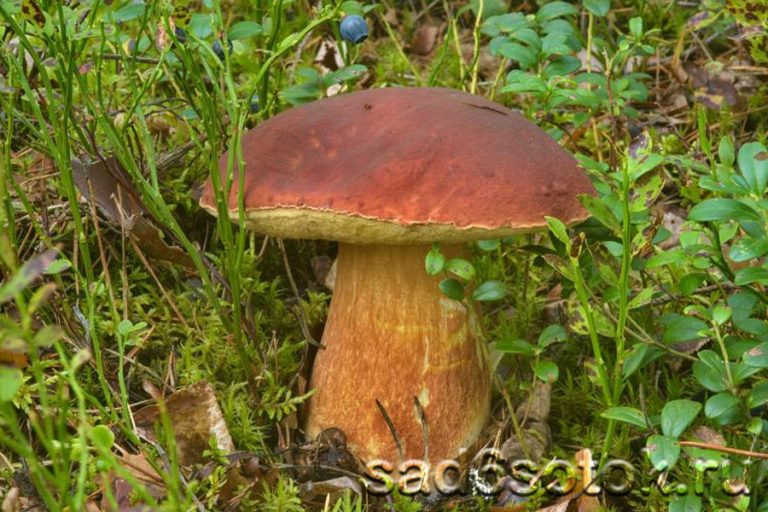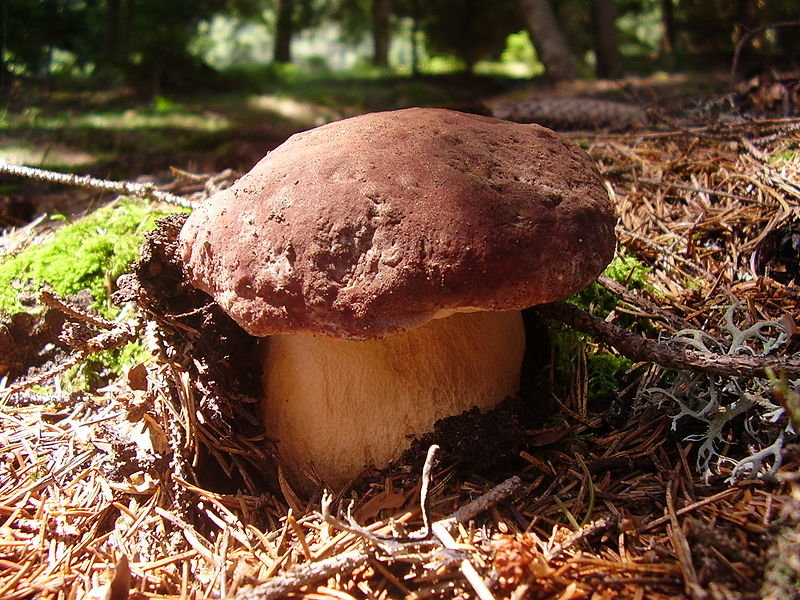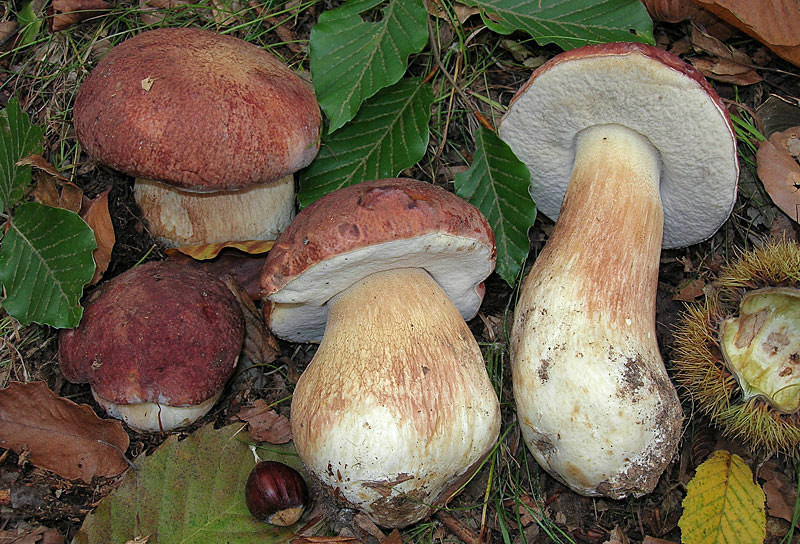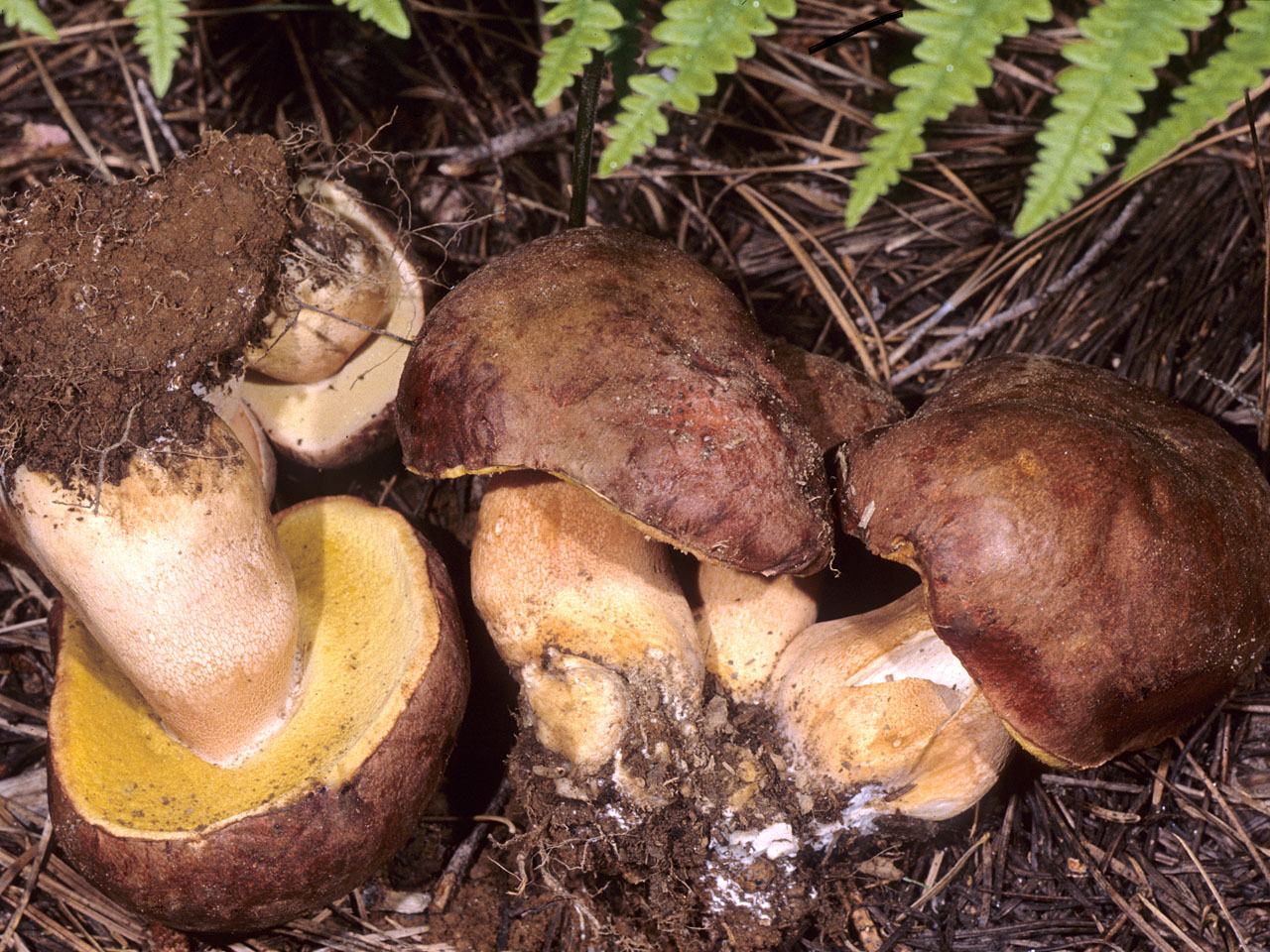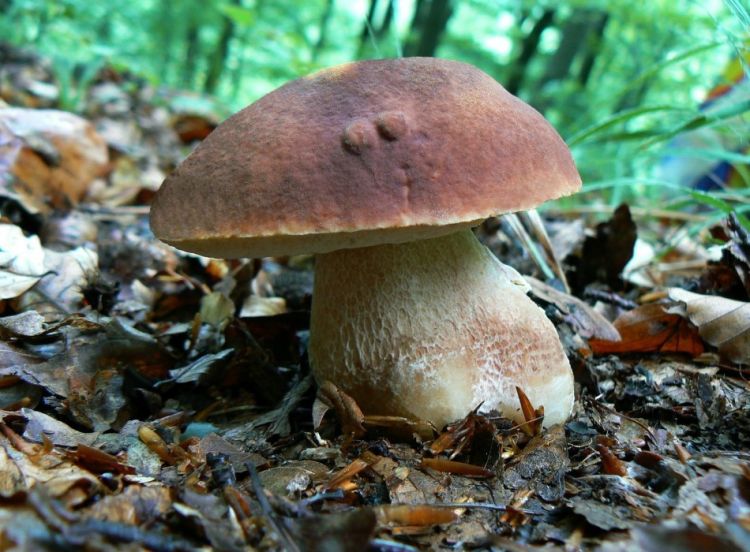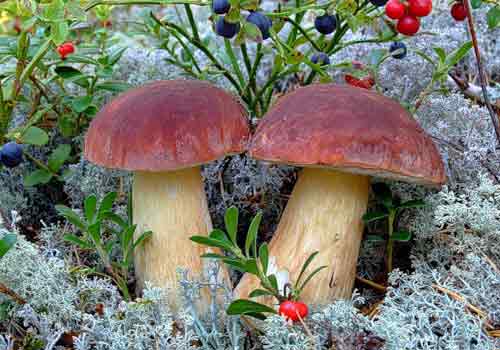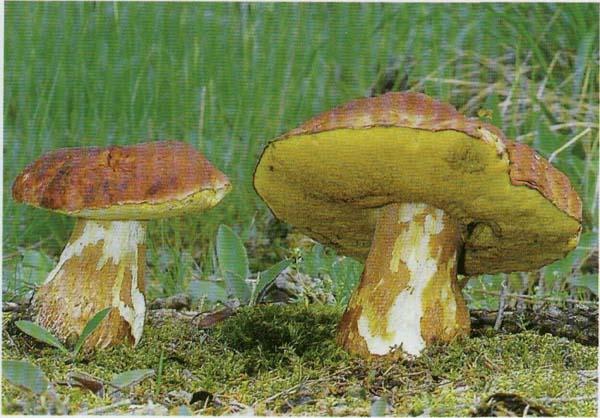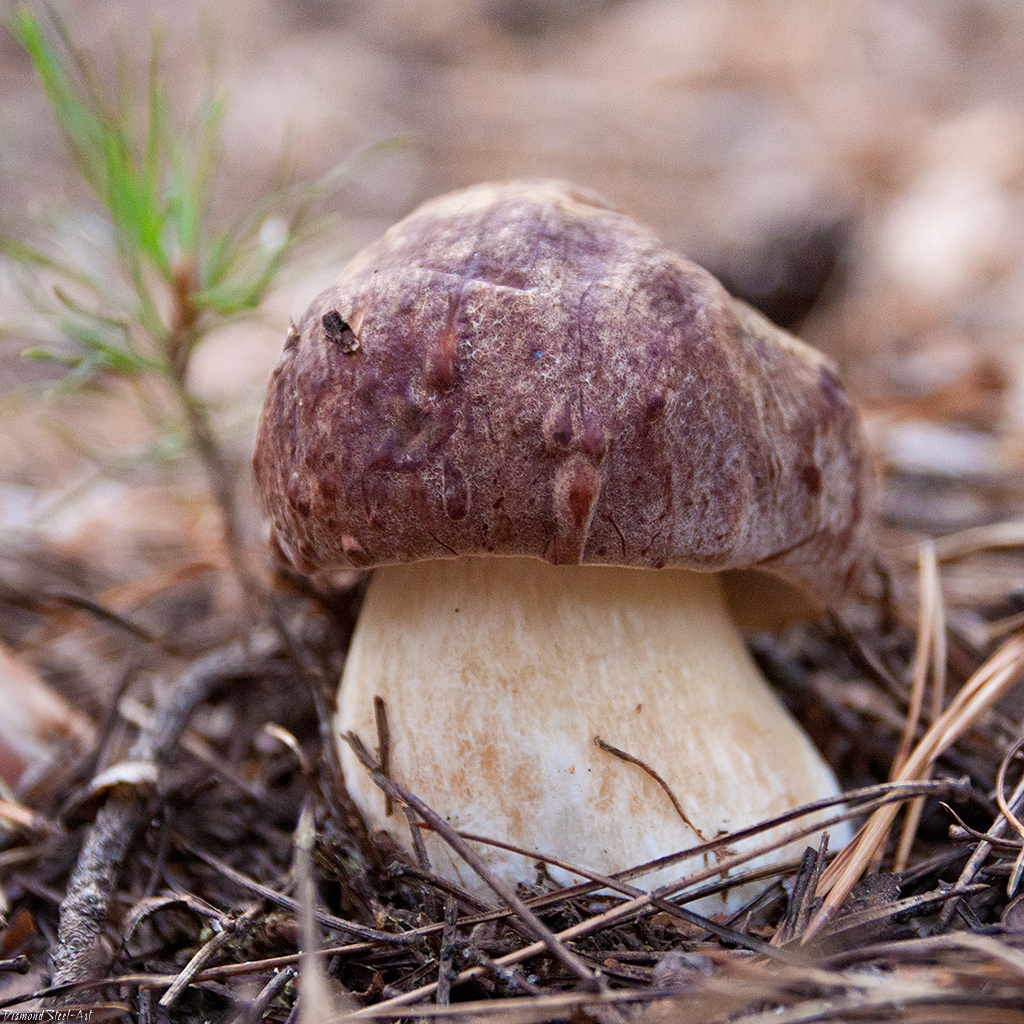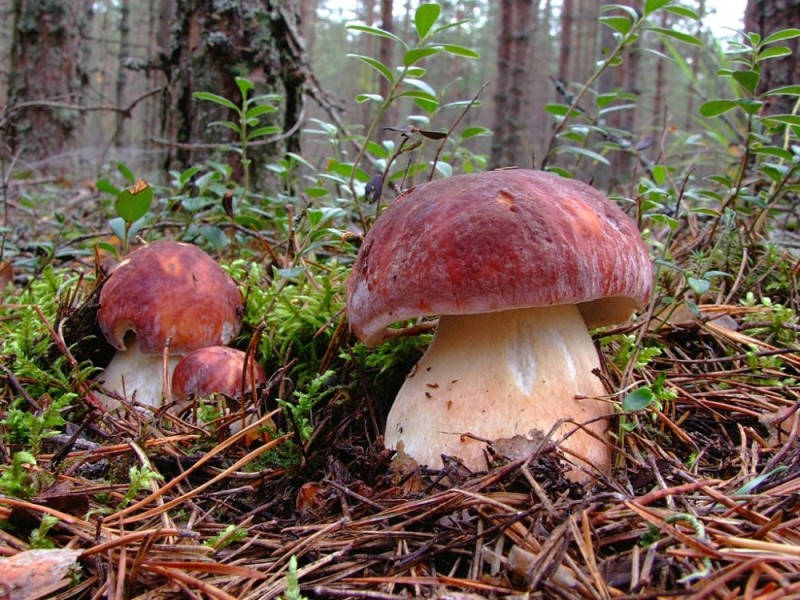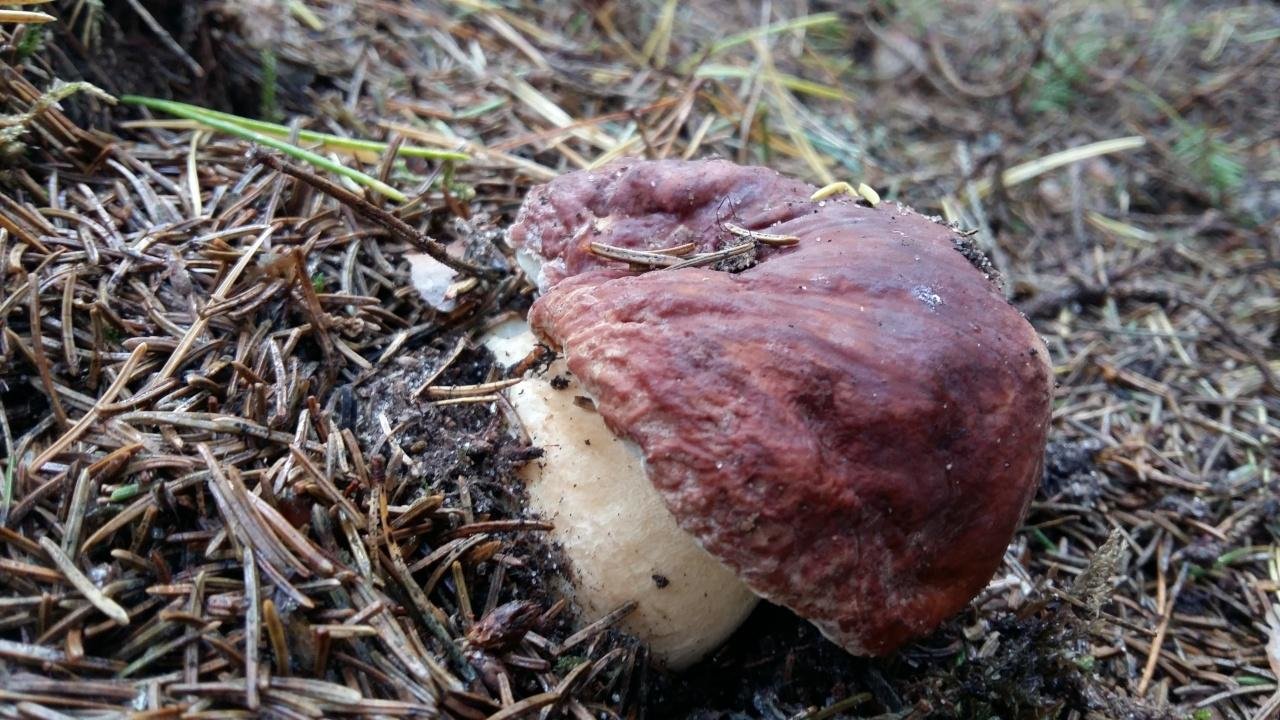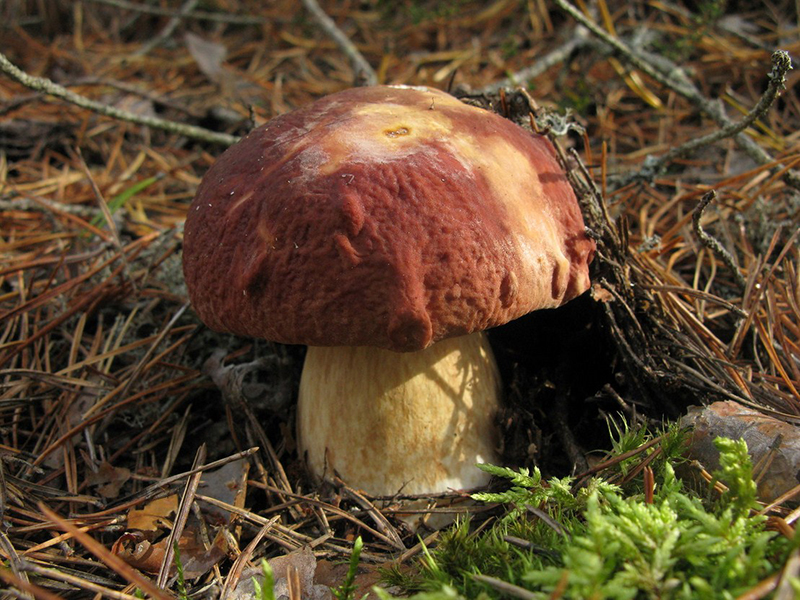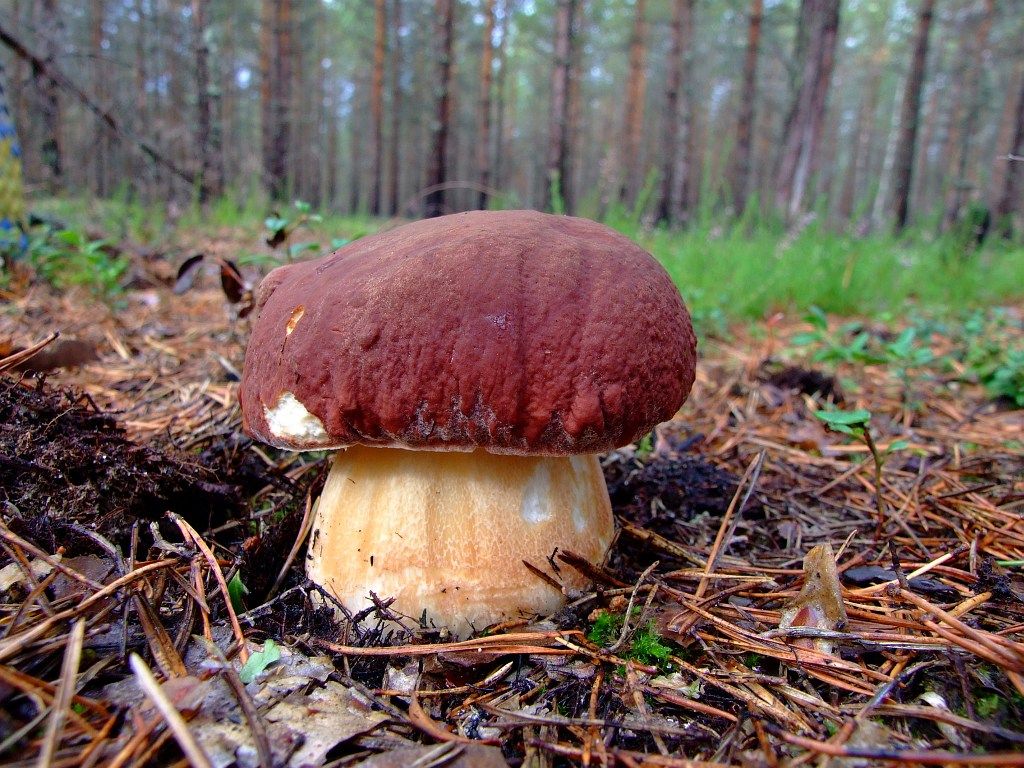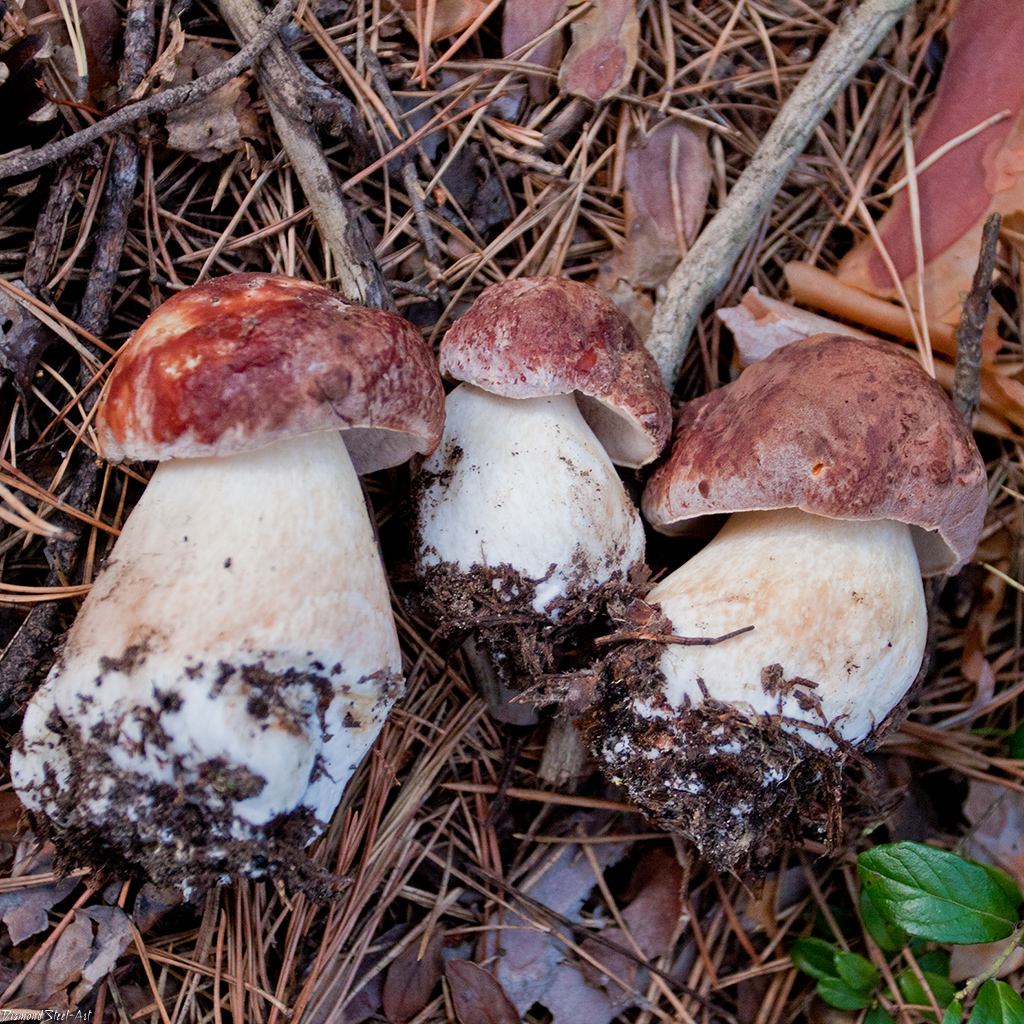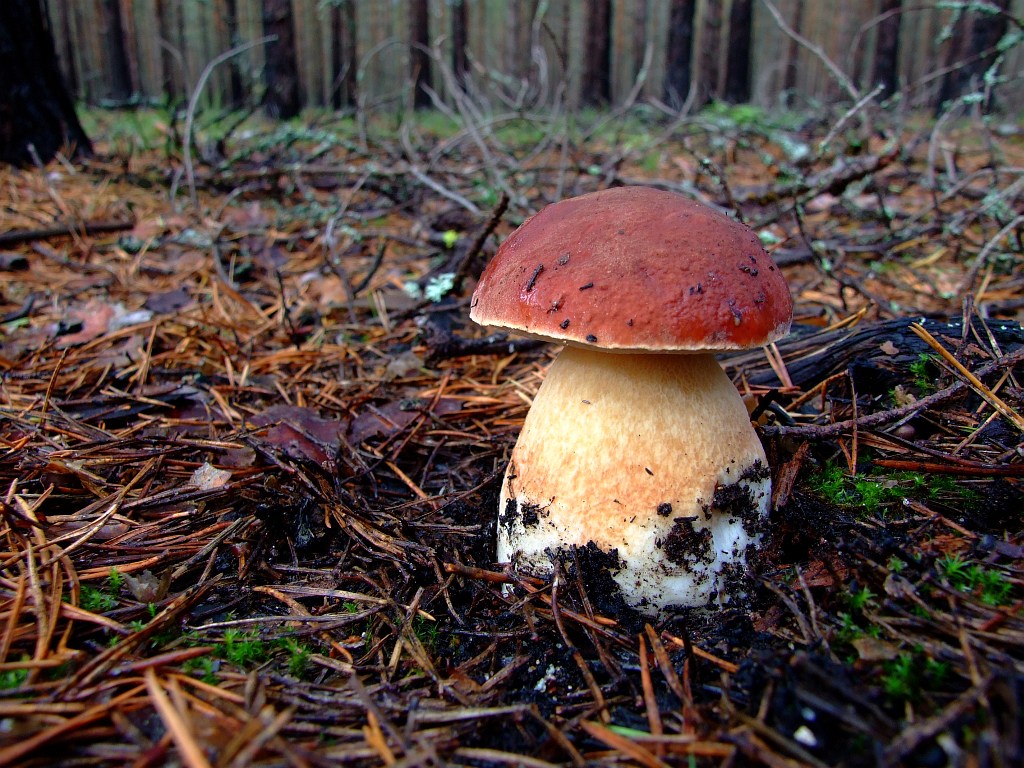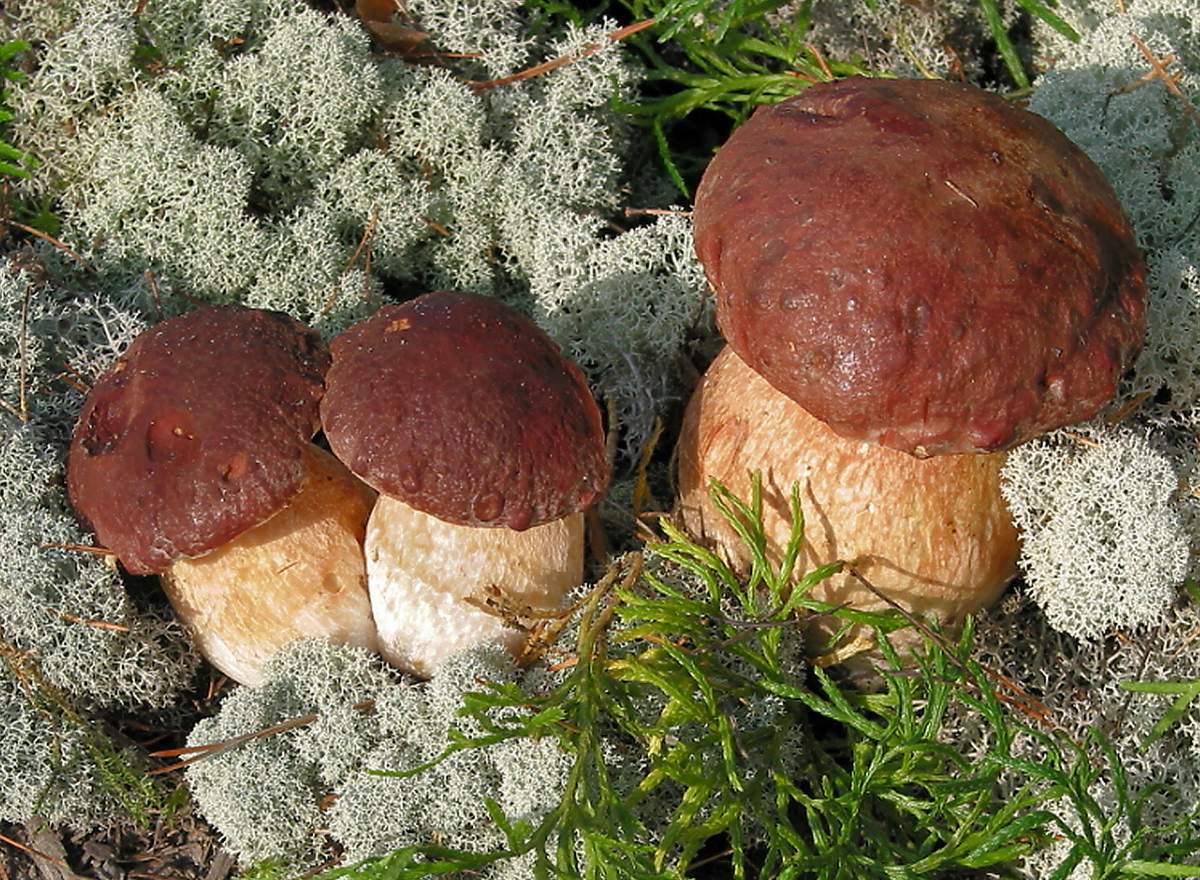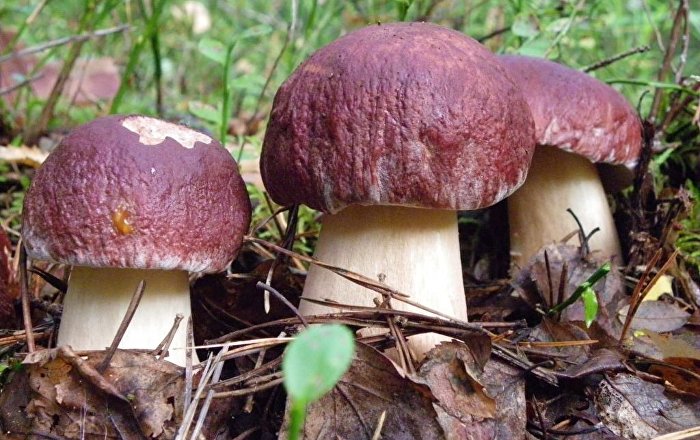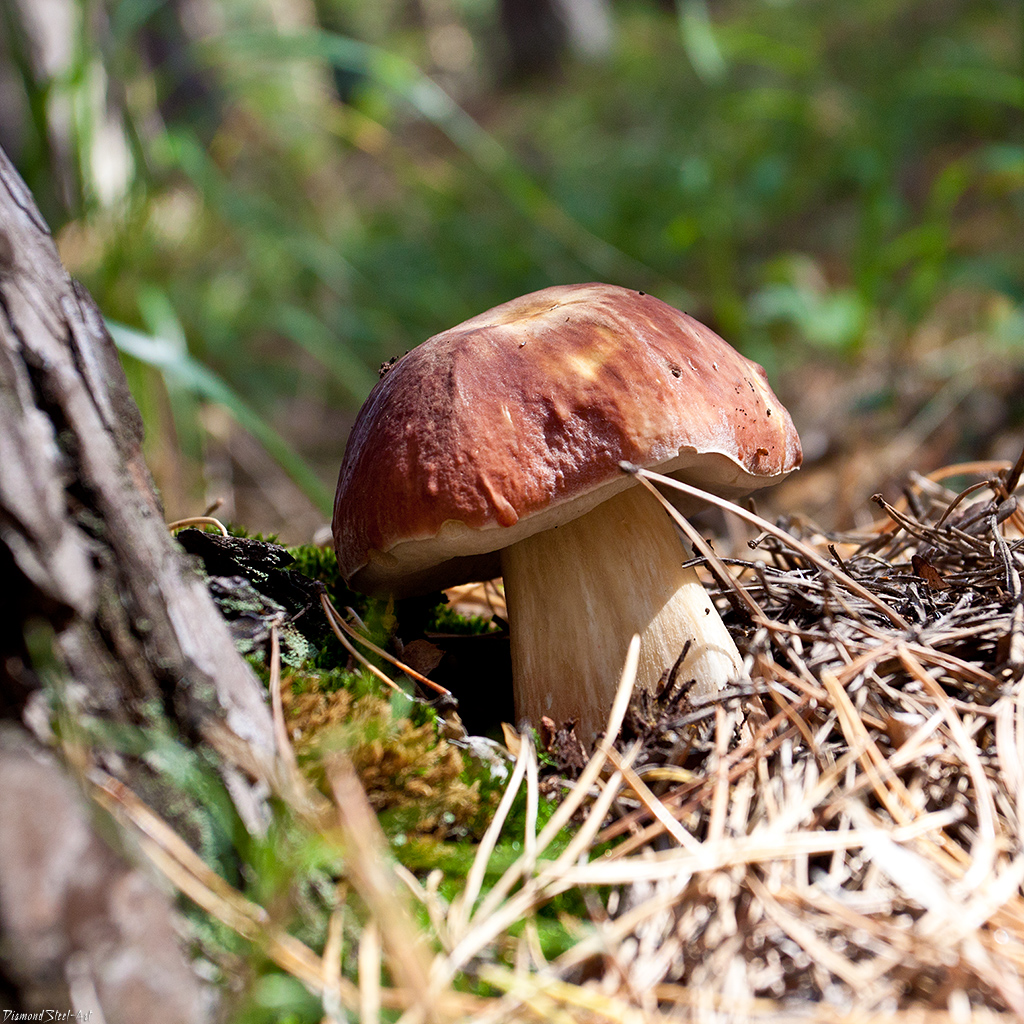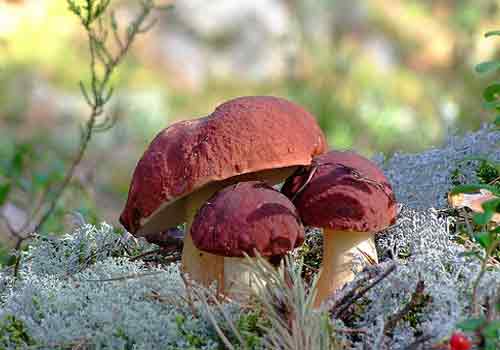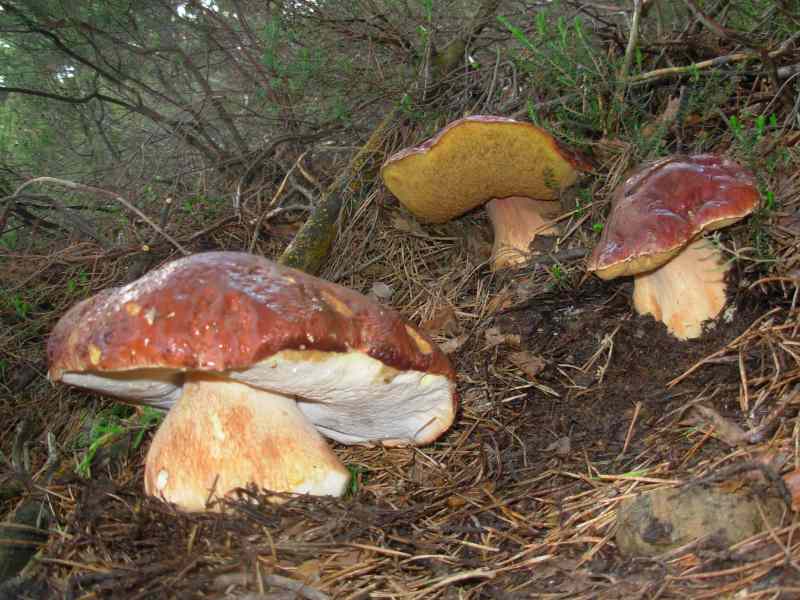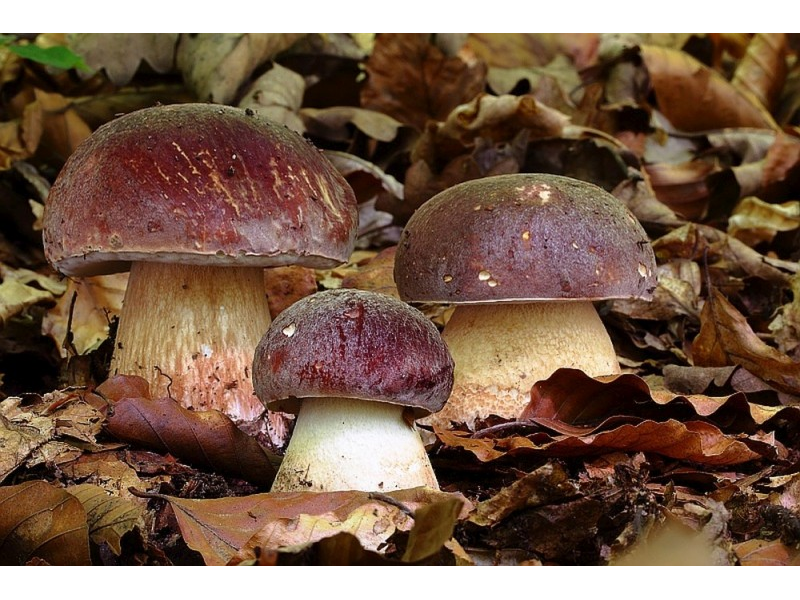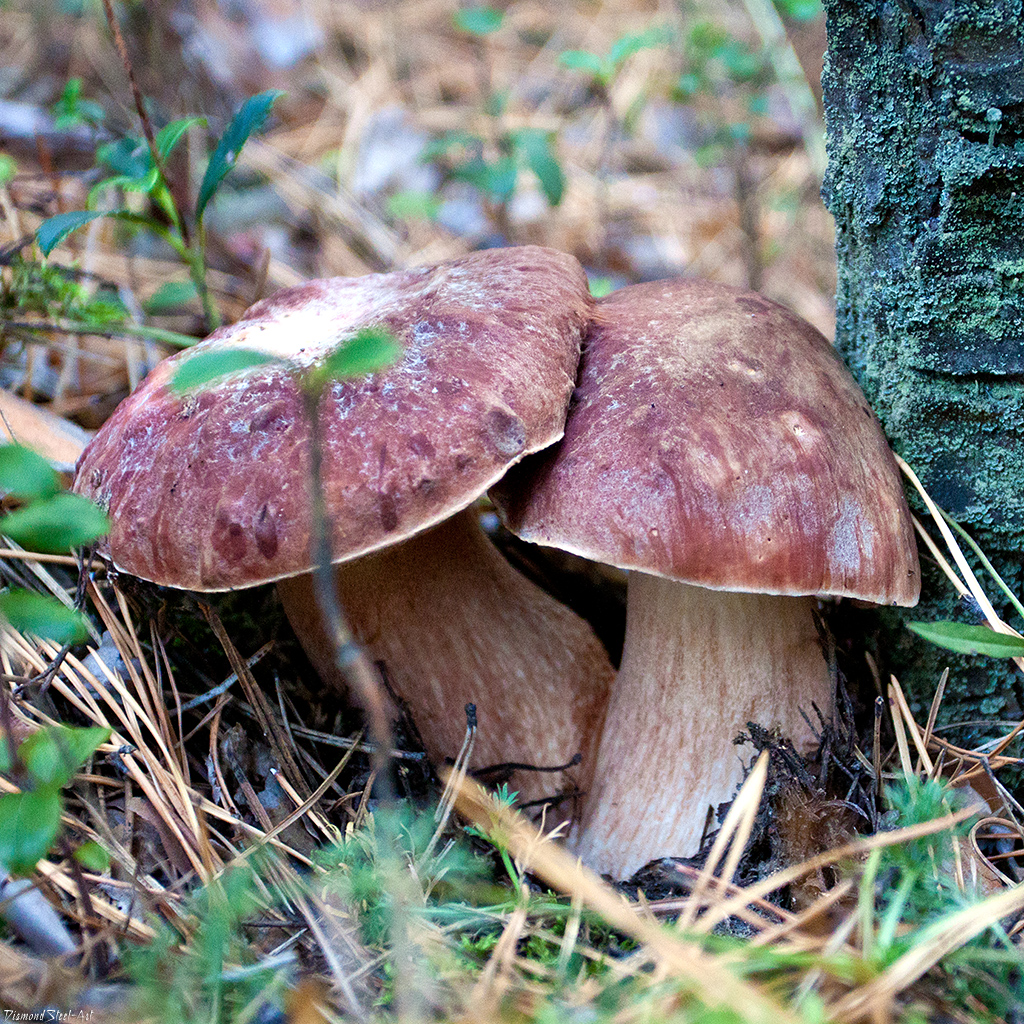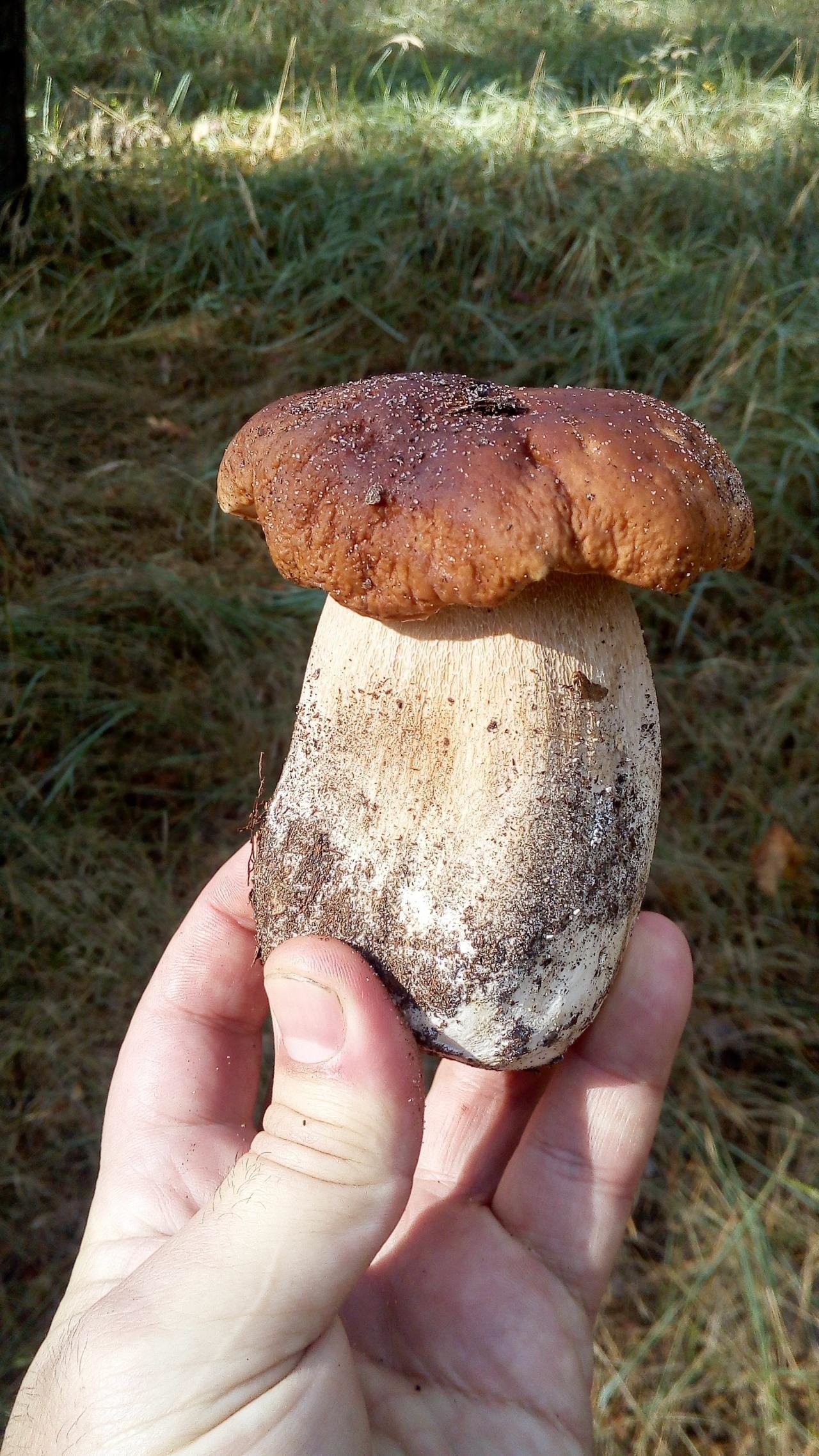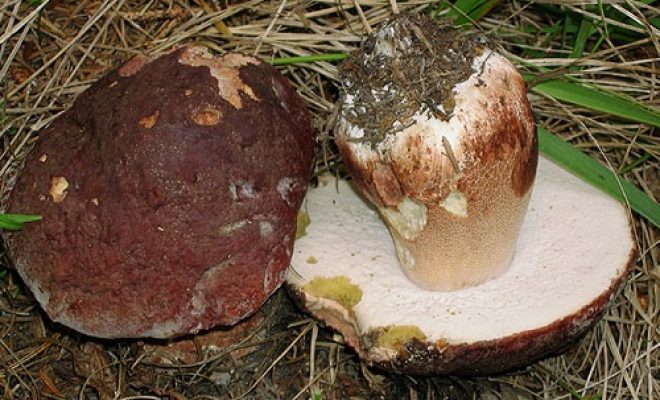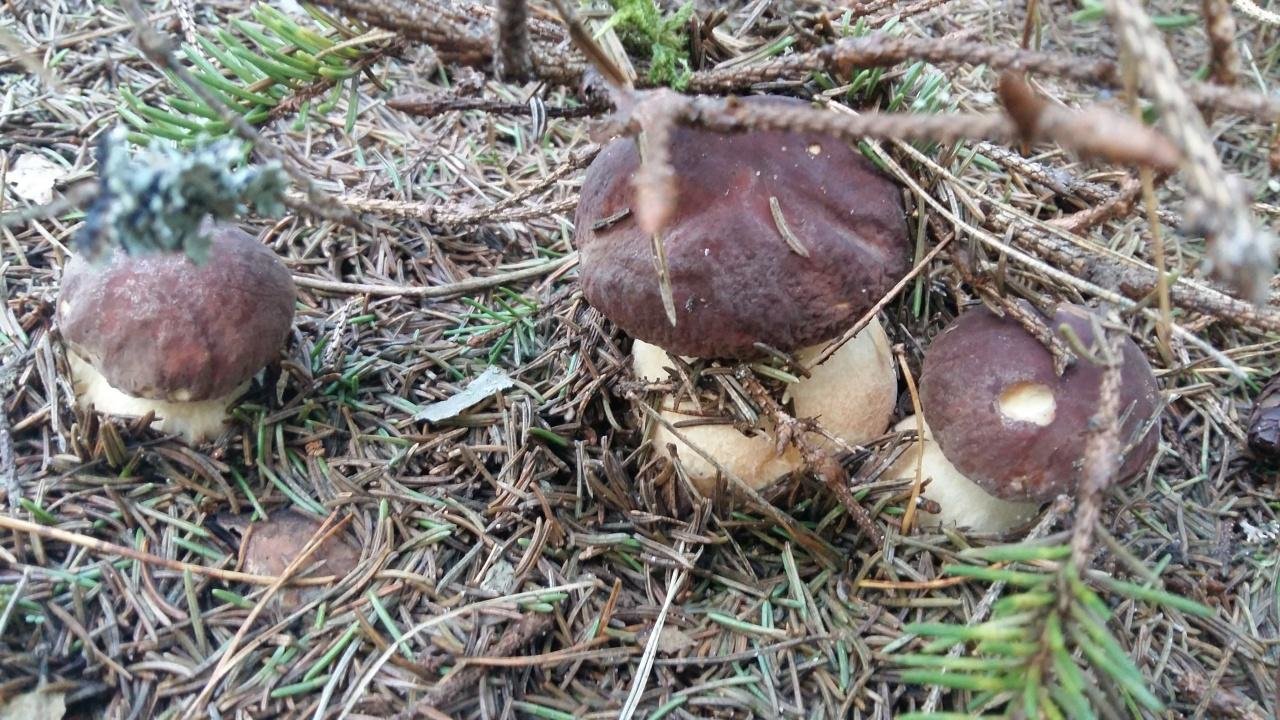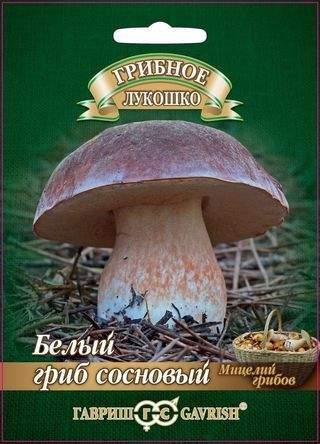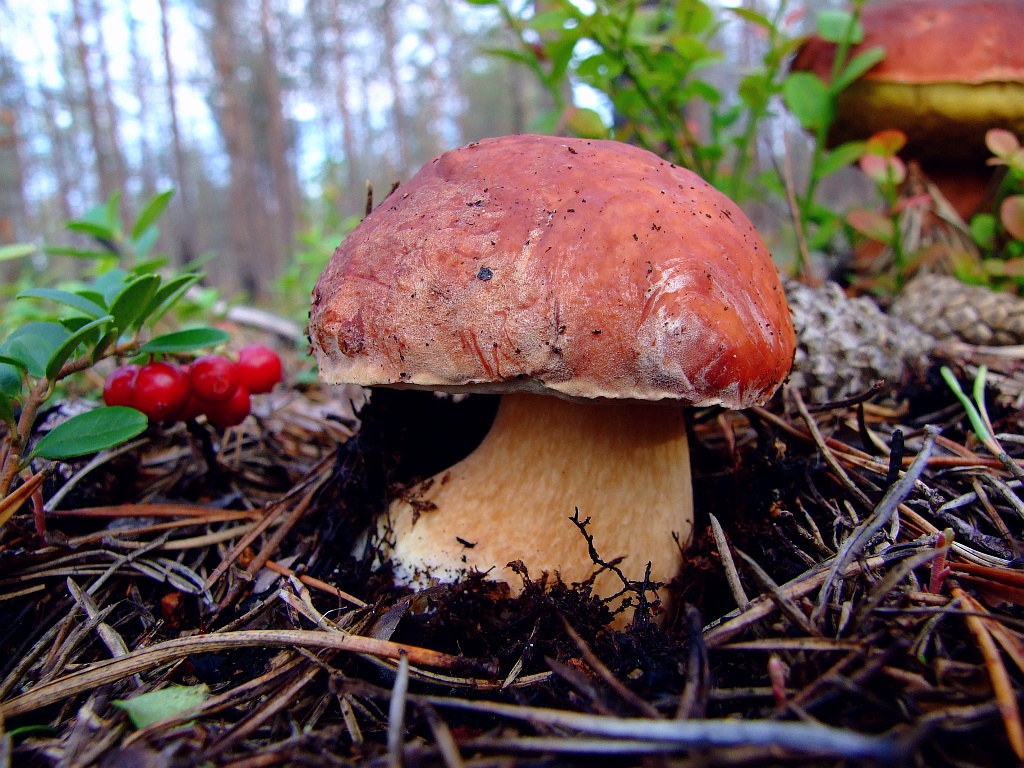Varieties
Boletus mushrooms grow everywhere in the forests of Russia, and there are a great many species of them. It can be seen that they are all from the same genus. They are distinguished only by the nuances of their appearance. All belong to the first taste category, each has an inedible double. Therefore, starting a "quiet hunt", carefully study the external signs of those mushrooms that are found in your area.
Pine
Its external features practically repeat the general description of boletus. What are the differences:
- The hat is red-brown with a diameter of 8-25 cm. The shade is purple.
- Pulp. Under the skin it is pink.
- The leg is very thick, short - up to 15 cm. Above there is a light brown mesh.
- The thickness of the tubular body is 2 cm. The shade is yellowish.
It has an early shape with a lighter head and flesh. Growth begins at the end of spring and continues until October. It settles under the pine trees - hence the name. With them, it forms mycorrhiza - fungus root. Occurs on sandstones, alone and in families. Distribution area - Europe, America, the European part of Russia.
Birch
Its second name is spikelet. It is harvested when the earing of rye fields begins. Distinctive features:
- The hat is light yellow, 5-15 cm in diameter. The flesh has no pronounced taste. It does not darken at the break.
- The leg is barrel-shaped, with a light mesh.
- The thickness of the tubular layer is 2.5 cm. The shade is yellowish.
It prefers to grow under birches. They grow singly and in groups. Favorite places - on the edges, near the roads. Distribution area - Western Europe, Siberia, the Far East. The harvesting season is June-October.
Dark bronze
Hornbeam or copper. Species differences:
- Rounded fleshy cap with a diameter of 7-17 cm. Dark shades. Sometimes cracked.
- The pulp is white. With a pleasant aroma and taste. In a fault, it changes color.
- Differs in a massive leg - it is pinkish-brown. Covered with brown mesh.
Tubular layer 2 cm thick. Yellow, when pressed - turns green.
Grows in deciduous forests in warm climatic zones. Distribution - Europe, North America.
Other varieties
There are also such varieties of porcini mushroom:
- Reticulate. He has a brownish or light ocher cap. The leg is short, cylindrical. Can be confused with a flywheel. Prefers beeches and hornbeams. It grows in Europe, North Africa and North America. Has a pronounced mesh on the leg. Fruiting time is June-September. It is rare.
- Oak. The hat is grayish. Sometimes there are light spots on it. It differs from other boletus in looser pulp. Prefers oak groves. Habitat - Caucasus, Primorsky Territory. It has a brown cap, very similar to a gall fungus.
- Semi-white mushroom. The color of the cap is light brown or clay. Dense pulp - smells like carbolic acid. Distribution area - Carpathian region, Polesie, southern Russia. There is no mesh pattern on the leg. The hat is light brown.
White mushroom net
White oak mushroom
Semi-white type of porcini mushroom
Spreading
White mushroom is widespread in the forest zone around the world, except Australia, mainly growing in birch forests, pine forests, oak forests and spruce forests.
The main areas of distribution of porcini mushrooms: almost all of Europe, and North and Central America, North and South Africa, in Asia it is known in Turkey, Transcaucasia, northern Mongolia, China, Japan, in all regions of Siberia and the Far East, sometimes it can be found in Syria and Lebanon on old oak stumps. It was brought to South America (Uruguay) with plantings of mycorrhizal trees. It grows in Iceland and the British Isles.
The white mushroom is one of the species that penetrates the arctic zone the most; only a few boletus trees go further north.In Russia, it occurs from the Kola Peninsula to the Caucasus and from the western borders to Chukotka, but it is unevenly distributed. In the tundra it is very rare, it is known only in the mountain tundra of the Khibiny, Kamchatka and Chukotka, in the forest-tundra it is also rare, but in the northern taiga, directly adjacent to the forest-tundra, it can already be found very abundantly. The abundance of porcini mushroom decreases in the direction from west to east from the European part of Russia to Eastern Siberia, while in the Far East it can be found abundantly. In the forest-steppe, its abundance sharply decreases, but the fungus completely disappears only when it moves to the steppe zone. In mountain forests, it is less common and usually less abundant than in plains.
The porcini mushroom is considered a light-loving species, but in some forests it can also be found in highly shaded places, under dense crowns. It has been established that in harvest years the number of mushrooms does not depend on the illumination, and under unfavorable conditions (waterlogging of the soil, low daily temperature), mushrooms appear mainly in open, well-heated areas.
The optimum fruiting temperature in July and August is 15-18 ° C, in September 8-10 ° C. Large fluctuations in day and night temperatures and a large amount of precipitation hinder the development of fruit chalk. The optimal meteorological conditions for the mass appearance of the porcini mushroom are considered to be short-term thunderstorms and warm nights with fog.
The porcini mushroom is well adapted to any type of soil, except for marsh and peaty, growing singly or in groups. It grows best in well-drained but not waterlogged soils.
Semi-white mushroom - description, where it grows, the toxicity of the mushroom
He received this name from the people. The most common scientific name is Boletus impolitus. In some literature, it is also found under the names: semi-white is sick, boletus is yellow, as it represents the Bolet family, a genus of boletus. The semi-white mushroom is considered one of the most delicious mushrooms that live in our forests. Today it is quite rare and will soon be included in the Red Book as an endangered species.
Description
A semi-white mushroom or yellow boletus is an edible, tubular representative of the mushroom family. It mainly lives in mixed or deciduous forests of our homeland. He loves lime soil very much. A convenient time for picking is from July to September, most often such a mushroom can be found under an oak tree.
- The size of his hat is initially 5-6 cm, and in an adult mushroom it can reach 20-22 cm. Such sizes are considered record-breaking for mushrooms. Initially, in a young mushroom, it is strongly convex, and then, during growth, it becomes cushion-shaped, flattened and ragged. The skin is matte, it does not separate from the pulp. Color characteristics in nature are found in different shades - from yellow-brown to olive and gray-brown. The lower tubular layer is golden.
- The leg is thickened to 7 cm, reaching a height of 10-12 cm. Rough to the touch, closer to the root, coarse-fibrous. Inside, straw-lemon color, burgundy on top.
- The pulp is powerful, thick. In general, the color is golden wheaten, in some places near the stem the color is rich lemon. The smell of such a mushroom vaguely resembles the smell of gouache paints or, as many say, has a carbolic smell.
Habitat and collection time
The semi-white mushroom is a very thermophilic family of mushrooms. Therefore, it mainly lives in the southern and central part of the Russian Federation, it can also be found in some corners of the Carpathian Mountains. You need to look for yellow boletus in mixed forests, often found in coniferous forests. He is especially fond of moist lime soil. In favorable weather, they bear fruit from early summer to late autumn. Despite the fact that in recent years it has been extremely rare, in a favorable year with suitable conditions, a very large harvest can be harvested.
Taste characteristics and benefits
Yellow boletus is an edible mushroom that is allowed for consumption.It is very tasty in itself, it has a great rating among mushroom pickers. The specific smell disappears during cooking.
A semi-white mushroom is suitable for various types of cooking. Most often it is dried, pickled, boiled and fried. Mycologists say that the variety of this mushroom is very useful for the human body. When eaten, a person receives a large amount of vitamin B, as well as:
- Improves the functioning of the nervous system.
- It has a positive effect on hair and skin.
- Normalizes the endocrine system.
- Helps to improve the level of hemoglobin in the body.
- Strengthens bone tissue.
- Improves the immune system.
Due to the fact that the mushroom is rich in ascorbic acid, it is recommended to use it for acute respiratory infections. In the case of constant consumption of food, the chance of getting a cold, flu is significantly reduced.
It is especially important to remember that even when frozen, the mushroom retains all the useful elements. This is a big plus when preparing the hostess for winter.
Contraindications to use
This mushroom is prohibited:
- Children under the age of 10 (the digestive system is not fully formed).
- People suffering from diabetes mellitus (a disaccharide is present in the fungus).
- People suffering from kidney disease (the fungus may contain a large amount of nitrates).
A semi-white mushroom does not have any substances that could harm a person.
But it is important to remember that the mushroom absorbs all substances from the soil, so you should not collect it near roads, factories, highways and in other ecologically polluted areas of our nature.
Similar species
- Boletus edulis is a common name for a white mushroom.
- Boletus appendiculatus - girlish pain.
- Boletus radicans, syn, Boletus alb> Due to the disappearance of this species, scientists urge to treat it with care and understanding. So that our descendants could also feast on the Yellow Boletus.
Eating
Experts believe that it is the porcini mushroom that is one of the most delicious mushrooms that exist. It can be consumed both dried and boiled and added to various dishes. As noted earlier, it is better to give your preference to younger fruits.
Processing methods
Drying, pickling of mushrooms and, of course, salting are considered the most common types of product processing. You can dry almost all mushrooms that have a tubular base. Drying is one of the main ways to process those mushrooms that belong to the spring harvest. But for our variety, such a yield is too small.
Taste qualities
Among all the edibles, even foreigners note this particular species. With various culinary treatments, it does not lose its taste, and in some cases even vice versa. Experience shows that old mushrooms with large sizes do not carry as much aroma and piquant taste as mid-season or young species. The older pine-loving Boletus is distinguished by the fact that, most likely, it has already managed to absorb a number of negative substances from the external environment. Eating it in food is harmful to your body.
Mushroom soup
Mushroom soup is a very tasty and common dish. The way to prepare it is simple. You will need to pour vegetable broth into a saucepan, and add a separate amount of potatoes there. Bring to a boil and soak for about seven minutes. At the same time, one must not forget that it is necessary to constantly monitor the foam. And as it arrives, it must be eliminated. Next, you can add mushrooms, which should be dried, as well as a number of other elements that you see fit to add. After that, the cooking process is carried out for 15 minutes. You can add special seasonings that are specifically addressed for this dish. As a result, the soup becomes ready. You need to eat it as fresh as possible, because only in this case the real taste of the dish is preserved.
Fried mushrooms with onion gravy
This dish is very simple and common. It is not difficult to fry Boletus pine-loving, but before this procedure you need to clean and rinse them properly. First, porcini mushrooms are washed, only then they can be cleaned. After that, they are cut and put in the pan. Fried half the time. Then the onion is added there.
Features of the view
The mushroom belongs to the Boletov family, the Borovik family. Therefore, his description often coincides with the characteristics of other representatives of this genus.
Satanic mushroom
Nevertheless, Satan has a number of individual morphological differences.
Appearance and photos
In appearance, this mushroom can be easily confused with boletus. You can assess the similarity by looking at the photo. The hat is hemispherical or pillow-shaped. Over time, it unfolds and takes on a prostrate shape. The diameter of the hat varies from 8 cm to 25 cm.
Mushroom cutaway
Some sources claim that the cap can reach up to 30 cm. Its surface is smooth or velvety, depending on the growing conditions. Most often it is dry, but can be slippery in wet weather.
The color scheme of the hat is varied:
- gray-white;
- gray;
- dark gray;
- gray with olive tint;
- gray-yellow;
- gray-green.
Less common are specimens with pink and olive streaks on a gray background of a hat. The leg grows up to 15 cm, its diameter is from 3 to 10 cm. Initially, it has the shape of an egg or a ball, but over time it becomes tuberous, similar to an uneven barrel or turnip. The leg is brown below, bright pink in the middle, and yellow-red above. A mesh pattern is visible over the entire surface.
The pulp of the mushroom is dense. It is often white with a yellowish tint. Sometimes there are specimens with lemon-colored pulp.
Morphology
The most striking specific feature of Satan is its chemical composition. Other representatives of the Borovik family remain white or turn blue on the cut, while the site of Satan's damage turns red. Another striking feature is the specific smell of the pulp.
Young mushrooms have a weakly pronounced spicy smell, and adults smell strongly of rotten onions. In addition, the surface of his hat is usually dry, which is not typical for most of his relatives.
Morphological features of the fungus
The satanic mushroom is classified as a tubular mushroom. Its spores are housed in short tubes under the cap. At first they have a yellow tint, but as they grow older, they change their color, becoming greenish, then brown, eventually acquiring a bright red hue. The spores are very small and roundish.
Distribution in Crimea and other areas
Satan loves the sunny edges of coniferous and deciduous forests, as well as calcareous soil. Most often it is found under oaks, lindens, chestnuts. The first representatives appear in June, and the peak of their growth occurs in July-August. At the end of September, the mushrooms disappear.
Satanic Mushroom Pulp
Satan is spread in the following places:
- Southern Europe;
- south of the European part of Russia;
- Caucasus;
- Near East;
- Primorsky Krai.
Some mycologists add Crimea to the above places. Local residents confirm the presence of mushrooms in the Crimean lands. However, according to official research, they have not been recorded in Crimea. This can only be explained by the rarity of the species and its small distribution. After all, the Crimean territory is the ideal soil for this species.
Eating
Satan belongs to conditionally edible mushrooms. In its raw form, it is definitely toxic, as it contains the venom of muscarine.
Long-term heat treatment weakens the toxicity somewhat, but does not completely eliminate it.
Residents of some countries, for example, the French, Czechs, eat Satan. They are pre-soaked for 10-12 hours, and then stewed the same amount. Mycologists say that after such processing, mushrooms can only cause an upset stomach.
Eating the mushroom
But is it worth the risk of trying them? Moreover, after such a long cooking, the taste is very doubtful. And the nasty putrid smell during cooking only intensifies, acquiring a sickening character.
When and where does it grow?
This type of fungus prefers to live at the foot of old pines. There are also exceptions to this rule, because abandoned mushrooms have been found more than once under Christmas trees or firs, oaks, chestnuts, and so on. It should be noted that the fungus of this species prefers to grow on more sandy soils, as well as in areas where there is a large amount of moss.
Porcini pine mushrooms are most often found in countries such as Russia, America, mainly the central part, as well as Western Europe.
The first mushrooms can please their consumers at the end of the first month of summer. But during such a period, they can only be found one by one in common areas. Professionals argue that the greatest demand for them is observed precisely in the fall, because then during the rainy season, the largest increase in yield is possible. At this time, you can observe quite large groups of mushrooms located under the trees and firs. It is in the fall that it is difficult to meet this species alone.
Features of growing at home
According to experts, it is possible and necessary to grow a porcini mushroom in your country house practically at home. In this case, you need to own a number of information that will multiply your chances of success in this type of activity.
It is important to understand that the more a mushroom is valued, the more attention it will need to care for and grow. Next, we present you with very important information, which will talk about two ways to grow this mushroom.
The first is with the use of mycelium, and the second is based on relatively fresh mushroom hats.
From mycelium (mycelium)
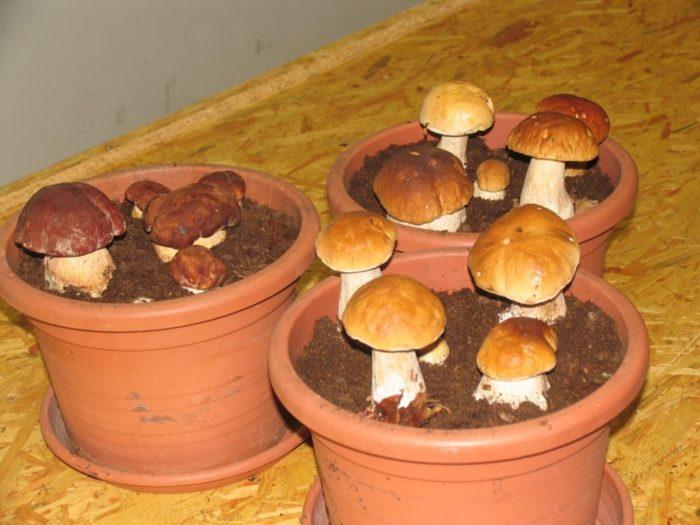
In addition to this material, you will need the following:
- Trees that grow during this period and it is desirable that they belong to conifers. And also it should be understood that it is better for these trees to be relatively young, no more than ten years old;
- You will need twigs, moss and fallen leaves;
- Compost as a growth promoter.
Planting of this type should be carried out between May and September.
After all the preparatory work, you can start planting the mushroom. We follow further.
- First of all, you need to prepare the area. In this case, a small layer of soil is removed near a certain selected tree. This is done using a shovel. You will also need to do so that there is a round area of one square meter.
- Further, this is the very place where fertilizer from the compost is laid. Next, the planting material is laid out in the form of a mycelium. It is best to place it in a checkerboard pattern. You do not need to plant more than one pack of mycelium under each tree.
- After planting, it is necessary to cover everything with a certain layer of soil from the one that was removed at the beginning of the procedure. Further, the necessary watering of the seedlings is carried out. But you should be careful, because water with a strong flow is a way to wash off the planting material. For this reason, watering must be done through a spray bottle.
- If there is a desire, then you can carry out an auxiliary action, in particular, cover the area with straw. The thickness of such a cover can be about 40 cm. Such a stroke helps to increase the moisture support in the soil by as much as 40 percent. The mycelium should never dry out. At a certain interval of time, the site requires watering, which will help maintain this moisture.
The mushrooms will not appear instantly, and you will have to wait about one year. This period is necessary for the mycelium to take root. These mushrooms will delight you with proper planting for about four years.
If you carefully deal with such a procedure, then the technology of the cultivation process is simple.
From hats
In total, there are no major differences between the landing procedure between the first and the second method. The main difference lies in the use of planting material. You will need trees and branches from them.
This process involves the use of mushrooms that can be found in the forest. The material in this case will be the direct bodies of the porcini mushrooms. But, in particular, you will need to use exactly the hats. In this case, you will need a more mature type of mushroom. They must be in such a condition that, when broken, the flesh of a green color is visible.
Do not pay attention to the fact that the mushrooms are infected with the larvae of certain insects.
Then you can safely start planting. The whole process is similar to the first one. You need to prepare the soil, plant these mushrooms, water.
When porcini mushrooms appear
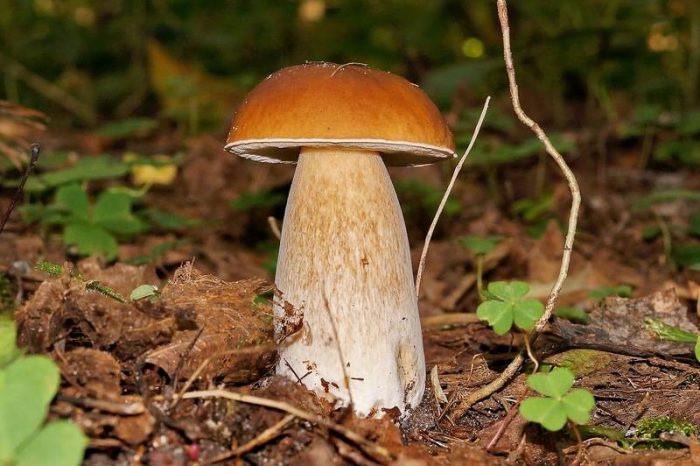
In northern temperate climates, the season for porcini begins in mid-June and lasts until the end of September, mass harvesting occurs at the end of August. The porcini mushroom appears briefly at the end of May, and bears fruit even in October in warm regions.
The optimum temperature for fruiting in July and August is 15 to 18 ° C, in September from 8 to 10 ° C. Fruiting bodies develop poorly with large temperature drops during the day and night, and heavy precipitation. The mass appearance of the porcini mushroom is facilitated by short thunderstorms and warm foggy nights. White mushroom is a light-loving species, but sometimes it is found in shaded places.
Description
The cap is 8-25 (6-30) cm in diameter, convex (cushion or hemispherical), then flatter, the surface is smooth or uneven, wrinkled or lumpy, slightly slimy in wet weather, dry - matte. The peel is not removable, the color is dark brown or red-brown, sometimes with a purple tint, lighter along the edge - from pink to almost white (in young people).
The flesh is dense, fleshy, white, does not change on the cut, brownish-red or pink under the skin of the cap. The taste is sweetish, poorly expressed, the smell is pleasant, mushroom or toasted nuts.
The stem is usually short and thick, 7-16 cm high and 3-10 cm thick, solid, often strongly thickened at the base. The surface is white or slightly brownish, covered with a reddish or light brown fine mesh, especially noticeable in the upper part.
free, with a deep notch near the stem, white, later yellowish to olive green. The tubules are 1.5-2 cm long, the pores are round and small.
There are no remnants of the bedspread.
Spore powder olive-brown or yellow-green, spores 14-20 × 4-6 microns, fusiform, smooth.
Varieties
Sometimes a dark red form is described (Boletus pinophilus var.fuscoruber (Forq.) Cetto 1987) with an even thicker reddish-brown stem.
An early form of the porcini mushroom (Boletus edulis f. Praecox, see porcini mushroom) appears in late spring. Vasilkov considers it a seasonal form of pine porcini mushroom. It is distinguished by a lighter color without a red tint and a slightly brownish (not red) pulp under the skin of the cap.
It grows on poor sandy soils, can be found on natural beaches or in fire-fighting trenches, less often on moss or black soil.
Useful properties of porcini mushroom
White mushroom is an edible mushroom, and in the countries of Eastern Europe, it is considered one of the best mushrooms in terms of taste, but there are some types of mushrooms that look somewhat similar to white mushrooms, but in fact, they are not only inedible, but also dangerous mushrooms. for example - a satanic mushroom.
In the people, the white mushroom is ranked among the so-called "noble mushrooms", and is called the "king of mushrooms".
The most delicious are porcini mushrooms found in spruce and birch forests. Porcini mushrooms collected from pine forests do not have a strong aroma and are distinguished by looser pulp.
White mushroom is used fresh (boiled and fried), dried and pickled. When dried, the mushrooms do not darken and acquire a special smell. In the form of mushroom powder (dried and ground) it is used for dressing various dishes.In Italy it is consumed raw in salads seasoned with oil, spices, lemon juice and Parmesan cheese. Porcini sauces go well with rice and meat dishes.
In terms of the content of nutrients, the porcini mushroom does not differ significantly from other mushrooms, and some species surpass it in the content of proteins (aspen) or food trace elements such as potassium, phosphorus (morel, chanterelle).
In addition to its taste, the nutritional value of the mushroom is explained by its ability to stimulate the secretion of digestive juices. Studies were carried out on the sokogonny properties of various mushrooms (white, boletus, boletus, oak, chanterelle), which showed that it is the porcini mushroom that is the best stimulant of digestion, surpassing even meat broth.
At the beginning of the 20th century, studies were carried out that showed that the protein of freshly prepared edible mushrooms is very difficult to digest, since it is enclosed in chitinous walls, which are not affected by digestive enzymes. Later it was found that after drying, the protein becomes available for the digestive system, up to 80% of the protein of dried porcini mushrooms is absorbed.

